Guests bring many different items when they travel and may inadvertently carry with them dangerous substances or items that are prohibited or restricted. Some common household items such as drain cleaners, paint, solvents, petrol, gas containers, fireworks, lighters, glues, detergents, bleach and aerosols are potentially dangerous goods.
IATA Dangerous Goods Regulation provides a list of dangerous goods. For the comfort, safety and security of all onboard RB flights, dangerous goods are either prohibited or restricted in your carry-on or checked-in baggage.
Prohibited items and baggage restrictions guides listed below or in this guide for your reference when you pack.
Important: Failure to declare dangerous and/or hazardous materials may result in civil or criminal proceedings, and severe penalties apply.
Prohibited Items
The following items must not be carried in your baggage (hand baggage and checked-in baggage):
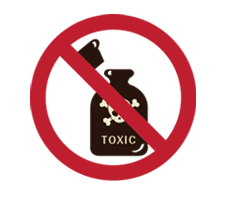
POISONSSuch as arsenic, cyanide, weed killer and tear gas.
|

WET CELL BATTERIESSuch as batteries filled with acid (e.g car), batteries filled with alkali (e.g. aircraft) or sealed non-spillable batteries (e.g. wheelchair)
|
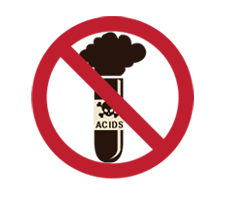
CORROSIVESSuch as mercury, acids, alkalis, thermometers containing mercury and wet cell batteries
|
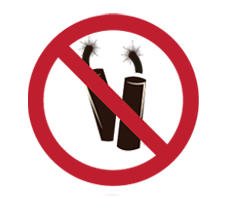
FIREWORKS & EXPLOSIVESSubstances and devices* capable, or appearing capable of being used to cause serious injury or to pose a threat to the safety of aircraft
|

DEEPLY REFRIGERATED / COMPRESSED GASSuch as butane, oxygen, propane and aqualung cylinders
|

CLASS 2 FLAMMABLE / NON-FLAMMABLE GASSuch as aerosols including aerosol paints, filled-aqualung cylinders, carbon dioxide cylinders for soda syphons, gas or fuel cylinders.
|

RADIOACTIVE MATERIALSSuch as instruments containing radioactive source radioisotopes for research
|

INFECTIOUS SUBSTANCESSuch as viruses and bacteria
|

MAGNETIC MATERIALSIndustrial strength magnets or magnetized material.
|
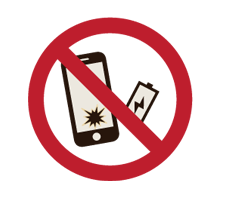
DAMAGED / DEFECTIVE BATTERIES & IN PORTABLE DEVICESLithium batteries that are defective or that have been damaged, have the potential of producing a dangerous evolution of heat, fire or short circuit and are forbidden for transport
|

BAGGAGE WITH NON-REMOVABLE LITHIUM ION BATTERIESSuch as baggage where the lithium battery is designed to charge other devices and cannot be removed, must be considered as power bank.
|

STUNNING / DISABLING DEVICESElectro shock weapons (e.g. Tasers) containing dangerous goods such as explosives, compressed gases, lithium batteries, etc.
|

OXIDISING MATERIAL AND ORGANIC PEROXIDESSuch as bleaches, resin kits and fiberglass repair kits.
|

HOVERBOARD / BALANCE WHEELSSmall lithium battery powered vehicles such as air wheels, solo wheels, balance wheels and hoverboards.
|

CLASS 3 FLAMMABLE LIQUID & CLASS 4 FLAMMABLE SOLIDSuch as lighter or heater fluids, paints, thinner, solvents, petrol and all matches are unacceptable in baggage.
|

FIREARMS & AMMUNITIONS Devices that discharge projectiles devices capable, or appearing capable, of being used to cause serious injury by discharging a projectile
|
SHARPS Objects with a sharp point or sharp edge capable of being used to cause serious injury
|
WORKMEN’S TOOLS Tools capable of being used either to cause serious injury or to threaten the safety of aircraft
|
BLUNT INSTRUMENTS Objects capable of being used to cause serious injury when used to hit
|
*Explosive and incendiary substances and devices such as ammunition, blasting caps, detonators and fuses, replica or imitation explosive devices, mines, grenades and other explosive military stores, fireworks and pyrotechnics, smoke-generating canisters and smoke-generating cartridges, dynamite, gunpowder and plastic explosives.
Any other substance or item which during a flight present a danger not covered above such as offensive or magnetic materials may also be prohibited.
Certain items are exempted such as guests having in their possession prescription medicine which may include medically necessary needles and syringes. A supporting letter from your doctor will be required.
Except for the following:

SHARP EDGES/POINTSAllowed as checked-in baggage only
|

MATCHES / LIGHTERAllowed as carry-on baggage only on person’s body however ‘Strike anywhere’ matches, ‘Blue flame’ or ‘cigar’ lighters are forbidden
|

E-CIGARETTES / VAPEAllowed as carry-on baggage only, however subjected to each country’s ruling
|
Fruits with Distinctive and Strong Smell
Fruits with overpowering and offensive smell like durians are prohibited as checked baggage and hand carry.
Carriage of Lithium Batteries
The abundant stored energy that makes lithium batteries practical also makes them dangerous when not carried properly. There are limits to the lithium batteries you can carry on board an aircraft.
Lithium batteries are two general types: Lithium Ion (Rechargeable) and Lithium Metal (Non-rechargeable). The terminals on spare batteries must be protected to prevent short circuiting. Methods include taping the terminals, putting batteries individually into plastic bags or using the original battery packaging.
Note: All Equipments in the checked baggage must be securely turned off
| Battery Type | Batteries | Carry-on baggage | Checked Baggage | Number of Spares |
|---|---|---|---|---|
Small Rechargeable & Small Non-rechargeable (up to 100Wh/up to 2g lithium) as used in:
|
In equipment | Yes | Yes, but recommended in your carry-on baggage | 2 pieces of laptop battery and 12 pieces of up to the equivalent size of AA batteries
|
Small Rechargeable & Small Non-rechargeable (up to 100Wh/up to 2g lithium) as used in:
|
Spares | Yes | No | 2 pieces of laptop battery and 12 pieces of up to the equivalent size of AA batteries
|
Medium Rechargeable (i.e. greater than 100Wh and less than 160 Wh) as used in:
|
In equipment | Yes | Yes, but recommended in your carry-on baggage | Limit 2 only. To be;
|
Medium Rechargeable (i.e. greater than 100Wh and less than 160 Wh) as used in:
|
Spares | Yes | No | Limit 2 only. To be;
|
In Medium & Large Non-rechargeable (i.e containing more than 2 grams of lithium)
|
Must be carried only as cargo/freight in accordance with the current dangerous good regulations | |||
| Large Rechargeable (i.e 160Wh and above) | Must be carried only as cargo/freight in accordance with the current dangerous good regulations | |||
| All types carried commercially | Must be carried only as cargo/freight in accordance with the current dangerous good regulations | |||
Watt hour (Wh) = Amps (Ah) x Voltage (v)
Example (14000 mAh 12 Volt) 14000/1000 (Ah) X 12 (V) = 168 Wh
Portable Chargers / Power Banks
- These are portable devices designed to be able to charge consumer devices such as mobile phones and tablets. The device comes in different shapes and sizes and may contain high Watt-hour ratings.
- For the purposes of the IATA Dangerous Goods Regulations, power banks are to be classified as batteries and must be assigned to lithium ion batteries, or lithium metal batteries, as applicable.
- For carriage by passengers, power banks are considered spare batteries and must be individually protected from short-circuit and carried in carry-on baggage only.
In line with safety regulations on the carriage of lithium batteries set by the International Air Transport Association (IATA) Dangerous Goods Regulations, the following policy applies on the carriage and use of portable chargers or power banks on all RB flights:
In cabin baggage (hand-carry)
Royal Brunei Airlines allow for the carriage of portable chargers or power banks in cabin baggage, under the following guidelines:
- Device cannot be discharged or used in flight at any time
- Device should not be charged at any time during the flight
- Device is switched off and placed in a sealed bag prior to the flight
- Device with lithium ion batteries Watt-hour rating that does not exceed 100Wh is permitted up to a maximum of 4 batteries per person.
- Device with lithium ion batteries Watt-hour rating exceeding 100Wh but not exceeding 160Wh is permitted with prior-approval from airline, up to a maximum of two batteries per person.
- Power banks without clear rating identification are not allowed to be carried on board.
- All power banks must be switched off, removed from your hand luggage, and placed in a plastic zippered bag in the seat pocket. Storing them in overhead compartments is strictly prohibited.
For checked baggage
Portable Chargers or Power Banks is strictly prohibited in checked baggage for all RB flights.
RB would like to remind our guests that should you need to charge your mobile phones or tablets, you may utilise the USB ports available at your seats.
- B787 Dreamliner: USB ports located below your Inflight Entertainment screens for Economy and underneath your armrest for Business Class.
- A320NEO: USB ports located below Inflight Entertainment screens
- A320CEO: USB ports located below Inflight Entertainment screens for Business Class and underneath your seats for Economy.
Carry-On Baggage Restricted Items
Civil Aviation Authorities safety & security require items that are restricted or dangerous to be removed from your carry-on baggage prior to departure, which may not be returned to you.
 |
 |
 |
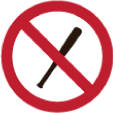 |
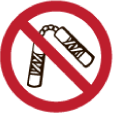 |
- Knives (Pen Knives, swords, hunting knives, daggers)
- Scissors and sharp objects (e.g. ice-pick, darts, razor blades, hooks)
- Ice Axes, box cutters, knives with blades of more than 6 cm, scissors with blades of more than 6cm as measured from the fulcrum, martial arts equipment with a sharp point or sharp edge, swords and sabres
- Items designed for chopping, such as axes, hatchets and cleavers
- Blunt instruments capable of causing serious injuries when used to hit such as baseball and softball bats, clubs and batons (e.g. billy clubs, blackjacks, night sticks) and martial arts equipments.
Apple 15-inch MacBook Pro
Apple has announced that the battery for some older generation 15-inch MacBook Pro units may overheat and pose a fire safety risk.
Royal Brunei Airlines restricts the use of 15-inch MacBook Pro units sold between September 2015 and February 2017 on board unless information is provided to verify the laptop is not affected by the MacBook Pro Battery Recall Program. These devices may be permitted for use in-flight if guests provide verification that their unit is not affected or that the batteries have been replaced. To verify if a device is affected by this recall, please visit: https://support.apple.com/en-gb/15-inch-macbook-pro-battery-recall
Guests that do not have proof of verification will be required to keep the device turned off, protect it from accidental activations and not charge it at any time during in-flight.
Smart Luggage
Effective 27th March 2025, smart luggage’s battery must be detached and kept in the seat pocket.
Smart Luggage is defined by bags powered by lithium batteries that may include motors, power banks, GPS, GSM, Bluetooth, RFID or Wi-Fi technology.
Smart luggage is allowed as cabin baggage (hand-carry) if:
- The lithium battery is removable
- The lithium battery must be removed from the baggage, individually protected in a zipped plastic bag/terminals taped/original packaging and placed inside the seat pocket in the cabin
- Adhere to RB’s cabin baggage allowance on the size and weight limit of not more than 7kg
- As smart luggage typically exceeds 7kg in weight, please either check in the baggage or ensure the baggage is within the 7kg cabin baggage allowance
Smart luggage is allowed as checked-in baggage if:
- The lithium battery is removable
- The lithium battery must be removed from the baggage and the lithium battery must be individually protected in a zipped plastic bag/terminals taped/original packaging and placed inside the seat pocket in the cabin
- Adhere to RB’s checked-in baggage allowance on size and weight limit
Smart luggage with removable lithium battery must adhere to RB’s Lithium Batteries limitation (refer to Guide to Dangerous Goods).
The Watt-hour rating of smart luggage with removable lithium battery must not exceed 100 Wh.
Prior approval is required if the Watt-hour rating of the battery is more than 100Wh but less than 160Wh.
Smart luggage with non-removable lithium battery is not permitted for carriage on all RB flights as cabin or checked-in baggage.
Guests are responsible to check the connecting airline’s requirement.
Samsung Galaxy Note 7
Effective 18 October 2016, Royal Brunei Airlines (RB) has prohibited the carriage of Samsung Galaxy Note 7 on all RB flights in accordance with the Brunei Department of Civil Aviation Security Notice dated 17th October 2016 which bans the carriage of Samsung Galaxy Note 7 on board all flights.
As a safety and precautionary measure, the prohibition applies to Samsung Galaxy Note 7 devices that are carried onto the aircraft in person, carry-on baggage, checked-in luggage and cargo.
Guests are advised that anyone found in possession of the Samsung Galaxy Note 7 will be denied boarding.
Liquids, Aerosols and Gels (LAGS) Restrictions
Restrictions may differ from country to country. Many countries have implemented restrictions on the carriage of liquids, aerosols and gels in accordance with the guidelines set by the International Civil Aviation Organization (ICAO).
The restrictions are:
- Liquids, aerosols and gels will only be allowed in cabin baggage if they’re kept in containers of not more than 100ml each, even if the containers are only partially filled.
- Containers must be carried in a clear, resealable plastic bag. The total volume of the bag must not exceed 1 litre.
- Each guest is only allowed one such plastic bag.
- The bag must be removed from cabin baggage and presented during security checks for visual and/or X-ray screening.
Medication, as well as food items for special dietary requirements including baby formula:
- are permitted in cabin baggage
- must be removed from cabin baggage and declared during security checks
- may be subject to additional security checks.
- If you are carrying prescription medicine, you are advised to carry supporting documentation (such as an ID card and a letter from your physician) for verification.
Should you carry more than the allowed limit during security screenings at the boarding gate, items will not be accepted for checked-in in the cargo holds and will be disposed.
It is encouraged that guests check the restrictions of the country you are visiting prior to your flight at IATA Travel Center
Rules for taking Liquids, Aerosols and Gels (LAGS) to Australia by transiting in Brunei
The Australian and Brunei Government have legislated new rules regarding the carriage of liquids, aerosols, and gels (LAGs) onboard flights to, from and transiting in Australia.
For flights arriving in or transiting in Australia
If you are carrying an excess of 100mls of liquid aerosols and gels in your hand luggage, it will be confiscated in Brunei, regardless of whether the items were purchased duty free from another airport, whether you are only transiting in Brunei, or whether the items were packed in a sealed temper-evident bag.
The airlines takes no responsibility should your duty free items gets confiscated by airport security.
Other countries are subject to their respective regulations and it is advisable that you refer the duty free vendors before you purchase any liquid items.
Pagers and Walkie Talkies from and through Dubai
Dubai Police have issued a new regulation banning pagers and walkie talkies on all flights departing from or transiting through Dubai. Any such devices found in passengers’ carry-on or checked luggage will be confiscated.
Banned items from and through India
Satellite Phones, GPS devices, e-Cigarettes, and Lighters are banned on all flights departing from or transiting through India. Any such devices found in passengers’ carry-on or checked luggage will be confiscated.
Electric Hair Curling Iron into South Korea
Electric Hair Curling Iron with integrated batteries (cordless curlers) are not permitted in either carry-on or checked baggage. These devices typically contain built-in lithium-ion batteries.
Carry-on Baggage (Cabin):
- Integrated batteries: Not allowed.
- Detachable batteries:
– The device may be carried if the battery is removed.
– Removed batteries must be protected from short-circuit.
Checked Baggage:
- Integrated batteries: Not allowed.
- Detachable batteries:
– Only the device may be checked in (without the battery).
– Removed batteries must be protected from short-circuit and carried in the cabin.

